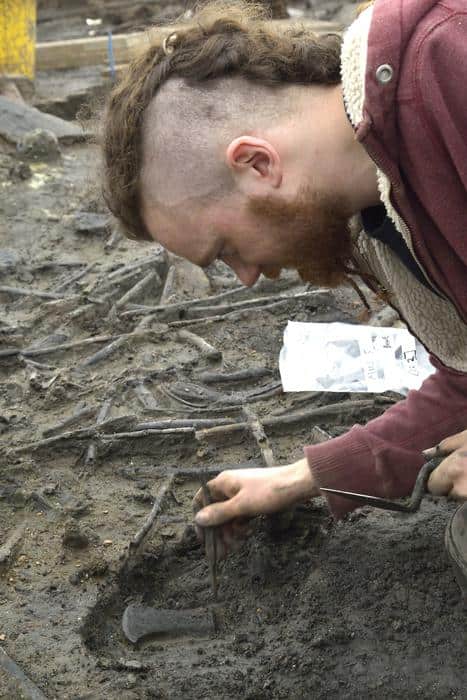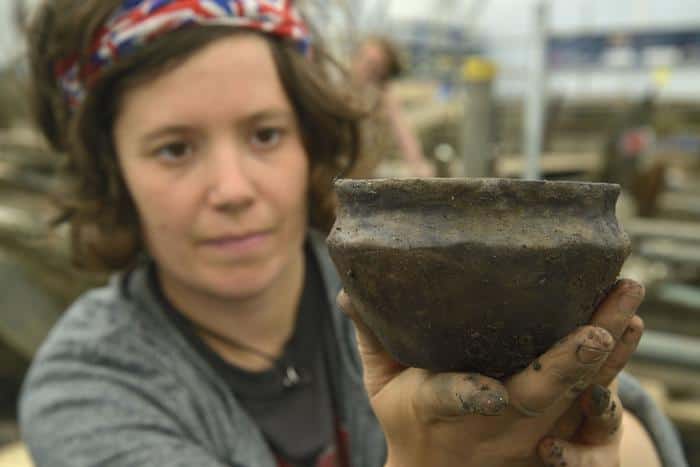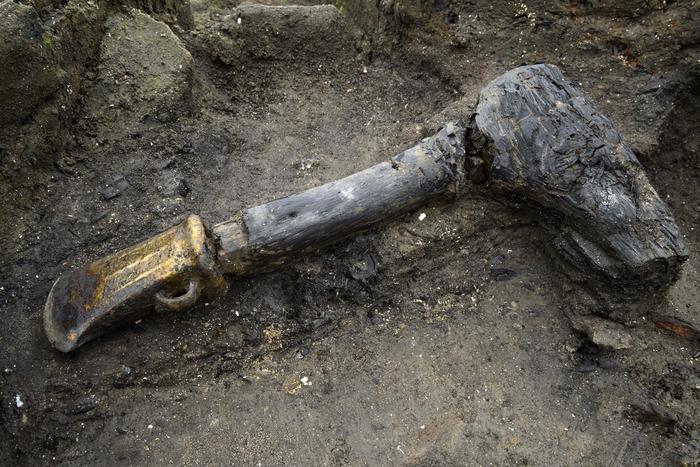Must Farm is one of the most interesting archaeological sites in Europe. Located in the Cambridgeshire Fens of Eastern England, it’s one of the most unique and remarkably well-preserved Bronze Age settlements ever uncovered. Often referred to as the “British Pompeii,” this site provides an unprecedented glimpse into domestic life approximately 3,000 years ago, during the late Bronze Age (about 1000-800 BC).

The archaeologists excavating the site have now uncovered four large wooden roundhouses and a square entranceway structure. All of them were built on stilts to protect them from the marshland and the slow-moving river. They would have been around two meters above the ground and were also surrounded by a tall, two-meter fence.
Must Farm was destroyed by a massive fire but now, it offers researchers a glimpse into what life was really like back then.
Everyday Bronze Age life
“I would say the most striking finding from Must Farm is that it is a site that gives us an incredible insight into the everyday life of its inhabitants during the Late Bronze Age,” says Christopher Wakefield, one of the field archaeologists, for ZME Science.
“The site’s destruction in a fire captured a moment in time, that lets us know what the contents of a home would have consisted of c.850BC. Each house had axes of different types, sickles, gouges, pots (complete with their contents), wooden objects and much more and we know the general quantities of each. This allows us to glimpse what their lives would have been like, something that is rare to be able to do for this period in prehistory.”

The settlement was less than a year old when it burned down. The buildings burned down and their contents collapsed into the muddy river below. But a tragedy for the locals was a boon to modern discovery. The abrupt event excellently preserved the artifacts, enabling archaeologists to study them now, some 3,000 years later.
“The fire heavily charred the organic finds, such as wood and textiles, creating a protective layer that helped prevent them from decaying. When the material rested in the river channel, the water and the character of the river’s sediments created an anaerobic environment (a lack of oxygen) that helped preserve the finds,” says Wakefield.
It’s not the first study at Must Farm. Archaeologists have been studying the area for years. But now, they’ve detailed the fen people’s lifestyles in unprecedented detail.
Pretty cozy
From the very architecture they used, you can tell that the houses were exquisite. This settlement is unique to the UK (from what we know so far), but several other settlements on stilts have been found in the Alps. Judging by the architecture, these people knew what they were doing, so this site wasn’t a one-off. There are likely other settlements like this one just waiting to be discovered in the area.
“The architecture of the pile-dwelling settlement was perfectly adapted to the landscape its inhabitants were living in. Its construction, requiring limited specialized woodworking skill, meant that most members of the community could have pitched in to help with its building, suggesting that the “blueprint” for the settlement was ideally suited for this environment. Its makers built it at a time when the river it was constructed over was at its lowest, to make the process easier and the materials, such as the wood, were cut down, brought to the site and worked and shaped at the location.
“With resources, such as tree species, having to be cut down and gathered from the edges of the wetland area, this suggests the inhabitants were aware of the resources in their wider environment and comfortable with the properties and qualities of different wood species (for example some artefacts are made from alder, a wood that has a natural resistance to rot and well-suited to wetland environments).”
The roundhouses had impressive roofs with three insulating layers: a straw layer, turf to cover it and a final layer of clay. This ensured that they were warm and waterproof but also well-ventilated — which, in the freezing winds of the marshland, would have made the houses “pretty cozy,” says Wakefield.

The village had a smaller square building that probably acted as an entrance to the settlement. In this settlement, there was a “recycling bin” — a wooden bucket with several damaged bronze tools like axe-heads. These tools would have been smelted down and recycled into other tools.
Unfortunately, aside from this the disposal hygiene of the village wasn’t so good. Around each cozy roundhouse there were “middens” — haloes of garbage dumped from the houses. Everything from broken pots to animal bones and poop was found there, and analysis of the human poop showed that the villagers struggled with intestinal worms.
Spectacular artifacts
The stilt houses also had a remarkable collection of tools and artifacts. For instance, houses featured a stack of spears that were over three meters long. They found a necklace with beads brought from Denmark and Iran, showing evidence of long-distance trade. They also had a huge range of pots. 128 pots of different sizes were uncovered, probably used for different things based on their size.

The flax linen textiles were also exquisite, some of the finest in Europe at the time. And the foods were remarkably finessed. The inhabitants had favorite cuts of meat, only bringing back the forelegs of boars for roasting, showing a life of Bronze Age luxury. They made meals of “honey-glazed venison” (an ancient version) and one pot showed a wheat-grain porridge mixed with animal fats (possibly goat or red deer). The occupant even saved “meat juices” as a topping for it.
But what got researchers even more excited is one particular tool.
One of the most exciting objects, a two-part hafted axe, was made in a way that allowed the axe head to be swapped out and replaced with ones at different angles or orientations. It is easy for people to assume that the inhabitants of the past living almost 3,000 years ago were primitive, but sites like this show that Late Bronze Age populations had an amazing understanding of materials and were far more advanced than many would believe,” says Wakefield.

Plenty more to uncover
From the meticulously crafted stilt houses to the diverse array of artifacts, Must Farm reveals a level of sophistication and innovation that challenges conventional notions of ancient societies. As researchers continue to uncover and analyze the wealth of data preserved within its muddy depths, the story of Must Farm promises to further enrich our understanding of prehistoric communities and their enduring legacies.
The preservation conditions here were remarkably favorable. But there’s a good chance other sites like this one have yet to be discovered.
With this new research, the archaeologists have concluded their work at Must Farm. But they continue excavations throughout the region.
“The hope is that one day we may be fortunate enough to come across another site similar to this one. The site’s construction, the way it was built and made, suggest this was not a “one-off” and was, in fact, a style of settlement. If archaeologists were able to excavate more river channels from this period, there is the possibility we may come across another,” concludes Wakefield.
The findings have been published in two reports, both made available by Cambridge’s McDonald Institute for Archaeological Research.






